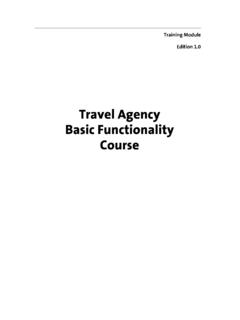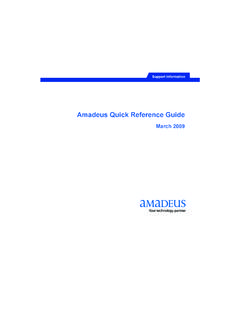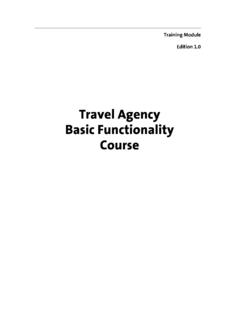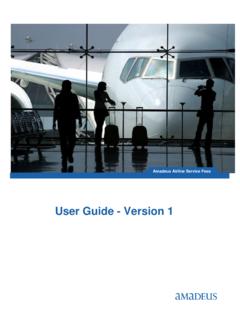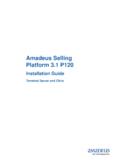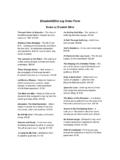Transcription of Shaping the future of Airline Disruption Management (IROPS)
1 1xxxxxxxxxxShaping the future ofAirline Disruption Management (IROPS)2 Shaping the future of Airline Disruption Management (IROPS)Executive summaryThe knock-on effects of Disruption Voice of the passengerA tale of two different travellers during disruptionTen common causes of Disruption Current market challengesIndustry trendsFuture vision Changing mindsets The passengerInnovation and automationView from the boardroom on collaboration Ten rules for communication during disruptionCollaborationContinuous industry improvementOne size does not fit allThe ideal IT solution for Disruption managementEnd-to-end Disruption Management RecommendationsConclusionMethodologyInde xThis paper was commissioned by sincere thanks to the interview participants from the following companies.
2 Accenture Advantage Travel CentresAmerican Express Global Business TravelANA Dallas/Fort Worth International AirportFlight GlobalGatwick AirportIATAM iami International AirportPATAPink Elephant CommunicationsSmall Luxury Hotels of the WorldSouthwest AirlinesStar AllianceSwissYas Viceroy Abu DhabiT2 RLTravel Technology Research Ltd, trading as T2RL, is an independent research and consulting company that specialises in the market place for IT systems. Based on data gathered and analysed since the year 2000, it has defined and tracked classifications of airlines and their IT providers. Its research is used by airlines to enable them to make informed choices of systems and vendors, and by the vendors to help them develop products that best meet the current and future needs of the Airline the authorIra Gershkoff is the Principal Consultant at T2RL.
3 He has more than 35 years experience with strategic and operational information systems in the Airline industry. At T2RL, he is responsible for market analysis of operations systems used by airlines around the world. He is a recognised expert in analysing Disruption problems and has written more than 20 technical papers and trade magazine articles. Prior to joining T2RL, he was the Chief Information Officer at Polar Air Cargo, a $350 million international air freight company. He also held executive positions at Sabre, United airlines and American The world is a book and those who do not travel read only a page. Saint Augustine3 Shaping the future of Airline Disruption Management (IROPS)IndexFrom the authorThis is the second of two papers on the Disruption problem that airlines around the world often face dealing with the consequences of cancelled or delayed flights.
4 Usually resulting from bad weather, these disruptions reduce Airline profitability and impose considerable delays on Airline customers. The first paper, Airline Disruption Management , focused on the clinical aspects of Disruption and highlighted potential systems solutions. The estimated cost to airlines and their customers is up to $60 billion per year, or about 8% of worldwide Airline paper concentrates more on the personal side of the Disruption problem, in terms of how we can orchestrate collaboration amongst managers of various independent organisations affected by a Disruption event. The customers the travellers themselves should also be consulted for their input onhow to manage the operating schedule. Improvements are needed on both fronts.
5 IT systems must account for what has already happened and indicate possible solutions for the future . The managers affected by Disruption are in the best position to construct a coordinated response across all the affected the research of this paper, everyone we talked to expressed some degree of excitement that this longstanding problem for airlines and travellers is finally being addressed. They were proud of their contributions thus far and looked forward to further progress. If this paper can stimulate a few more ideas and move things forward even a little bit, it will have done its GershkoffPrincipal Consultant, T2 RLForewordThe number of annual global air passengers will increase to billion by 2034 that s more than double the billion passengers that will travel this year.
6 Growth is great news, but it is a dizzying thought when one thinks about the challenges that lie ahead in order to accommodate and streamline this volume of passenger travel. It is in the interest of every party in the travel industry to think about how we can move things forward. airlines may appear to be at the heart of operations, but it is imperative to recognise that we, as an industry, are a symbiotic network when it comes to getting passengers from A to B. If Disruption hits one of us, it will hit the rest of us further along the are already being made to streamline protocols and IT systems that need re-thinking, and it s encouraging to see signs that the realisation is dawning on travel providers it s one thing to perfect our own operations and IT solutions, but how does that help when Disruption strikes an interconnected party?
7 We are a global travel ecosystem and need to find a way to act more like one. I believe the interlining of systems and standards is the only way we can effectively improve our response to Management is emerging as a higher priority for the investment and the involvement it requires to develop, as evidenced by the findings of this report. I hope you will find some useful perspectives, a new awareness of the Return On Investment (ROI) on improving our responses to Disruption , and some hope that progress is on an upward may never be able to prevent all causes of Disruption , but we can work together to ensure that when it happens, we are ready to respond with up-to-date strategies, effective operations and confidence that we can serve passengers more effectively than ever HusseinExecutive Vice President, Head of Asia Pacific, Eastern Europe and Turkey, Airline IT, Amadeus4 Shaping the future of Airline Disruption Management (IROPS)Executive summaryThis problem has existed for the entire history of aviation, described in the industry as irregular operations (IROPS)
8 , yet solutions have been hard to come by. While much time is spent in planning the efficient allocation of limited resources of aircraft and crews to produce a profitable schedule, there are few tools available to put the schedule back together again once it is disrupted. Attempts to solve this problem through automation have not had much success. There are a variety of reasons for this, but the common theme is the underlying complexity of all of the component parts. For example, the passengers on a flight to or from a major city can be travelling on 40 or more distinct itineraries. Aircraft and crews often go in different directions on completion of a flight, because each is subject to different regulatory rules and physical limitations.
9 It is like a massive jigsaw puzzle, where many of the pieces change shape as a result of unpredictable and especially weather Disruption cannot be prevented completely. But if a satisfying solution to the problem were available, it would have a number of positive impacts on various people within the Airline is also important to remember that travellers are not merely pieces on a chessboard. They are travelling with a particular need be it a business or a personal one. The end goal of Disruption Management is to help them get on with their lives more quickly after Disruption has had the experience of arriving at the airport for a departing flight, only to find that their flight has been cancelled or delayed. When multiple delays are caused by a single event, passenger itineraries and Airline schedules are seriously damaged.
10 Airline personnel scramble to reschedule flights and rebook passengers on other flights. Often, the Disruption problem spreads virally, because the flight that was cancelled in one city was supposed to provide the aircraft for a departure from another city. The problems tend to keep growing and it is not long before everyone is unhappy. The estimated cost of Disruption to airlines is 8% of Airline revenue, or $60 billion this report you will find:By the time you have read this report, airlines using Amadeus solutions could have helped 4,000 passengers recover from the effects of potential find out how, see page 26 and 27 and visit the future of Airline Disruption Management (IROPS)This report will look at Disruption from the perspective of many areas that are affected by it.

